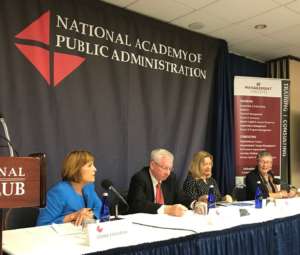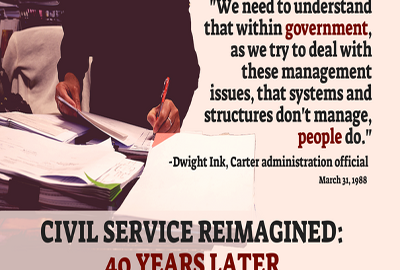
Fed community: Stop ‘tinkering around the edges’ of civil service reform
The National Academy of Public Administration said that every day spent dwelling on the minor challenges with the existing federal personnel system is another day...
Best listening experience is on Chrome, Firefox or Safari. Subscribe to Federal Drive’s daily audio interviews on Apple Podcasts or PodcastOne.
Good government groups and enlightened federal leaders have been talking about the concept of modernizing the civil service practically since the last major update to the federal personnel system in 1978.
They say the reports and white papers on these issues have been piling up over the years. But 40 years later, much of the federal community says it now seems to agree on what’s wrong with today’s civil service system.
But little has changed since Congress passed the Civil Service Reform Act back in 1978. Why?

It’s because the federal community has spent too much time focusing on tiny problems — and not the big, looming systemic challenges.
That’s the message from the National Academy of Public Administration, which on Tuesday released a new report outlining concrete actions government could take to move conversations on civil service modernization from mere discussion and debate, to concrete action.
“We’ve been spending too much time focusing on trying to solve the wrong problem,” Don Kettl, a professor at the University of Texas Austin and NAPA fellow, said at the organization’s report release in Washington. “So much of what we’re doing is to try to do is tinker with the individual bits and pieces of making the procedures work a little bit better, of trying to find ways of firing poor performers [and] trying to improve the hiring process — all of which we need to do.”
The report, “No Time to Wait Part 2: Building a Public Service for the 21st Century,” is a follow-on to a white paper NAPA released back in July 2017. Kettl spearheaded this most recent report.
And this time, NAPA took a different approach and offered up a new message: Every day spent not resolving these challenges with the existing civil service system is another day spent falling further and further behind.
The organization called on experts to look ahead well into the future and craft a vision for the federal workforce that addresses a future state that today’s managers and leaders may not be able to even predict.
“In a sense what we have is both a long-term plan we need to begin immediately and a short-term plan that we need to begin this afternoon,” Kettl said. “Between the two of them, we think we have the foundations for re-establishing and redefining a system that is based on mission, that underlines the enduring principles, redefines accountability and focuses on the ability to get government’s work done.”
Focus on ‘future state’ of work
The need is especially dire because the nature of work across the nation is rapidly changing, NAPA said.
Machine learning , natural language processing and other automation and artificial intelligence capabilities will fundamentally change the work that many employees across the country do on a daily basis, said Bryan Hancock, a partner at McKinsey and Company’s Washington office.
By McKinsey’s count, about one-third of the activities performed at 60 percent of today’s jobs can be automated within the next 10 years.
“Work is going to be re-conceived,” Hancock said. “It means that traditional job categories, in order to fully take advantage of automation and the changes, it can’t be done with the current jobs. The jobs are going to need to be reorganized. Automation is going to take some away, so you’re going to need to combine roles.”
Not all occupations will feel the same impacts. Automation has the potential to impact about 9 percent of current functions within management occupations, while workers in data processing jobs could see up to two-thirds of their work gone, Hancock said.
That means as the nature of work changes, future employers will prize strong soft skills such as creativity, communication and critical thinking over data entry or basic analysis skills.
For today’s federal managers, this means agencies not only need to prepare to reskill their employees for the next five years, but also the next 15-to-30 years.
“We need a system that is alert to the changing nature of work and the changing of the changing nature of work out there,” Kettl said.
Specifically, NAPA is calling for a competency-based system that assesses a person’s qualities and talents as whole. Instead of hiring a new person to fill a static position to perform specific activities, agencies should focus on finding top talent with the capability to meet the organization’s mission.
Title 5 house-cleaning
This year’s NAPA panel also offered perhaps it’s most definitive take yet on what specifically the federal community needs to do to prepare and modernize a decades-old civil service system for a new era.
There’s no doubt Title 5 needs a good “house-cleaning,” Kettl said, but NAPA’s panel acknowledged that a comprehensive overhaul of the federal classification and pay system — at least right now — isn’t a top priority for Congress.
Instead, NAPA called on the chief human capital community to form a 90-day action task force to examine existing opportunities to make administrative changes to status quo.
Flexibilities within Title 5 already exist, said Angela Bailey, the Homeland Security Department’s chief human capital officer. Bailey, who contributed to NAPA’s report, also spoke Tuesday but in her capacity as an executive with more than 30 years of human capital experience, not on behalf of DHS.
“If you look at Title 5, you could drive a truck through it,” she said. “[On] public notice, nowhere does it say that public notice has to be done by USAJOBS.gov. It’s an administrative thing. It’s a regulation that we’ve put in place, but nowhere [in law] does it say that. We have lots of ideas. We have lots of areas in which we could actually go ahead and go forward and address things administratively … and probably wouldn’t have to touch a lot of Title 5.”
But when agencies do run into the boundaries of current statute, individual organizations need authority to move with more flexibility and build the workforce they need to suit their specific missions, Bailey said.
“Right now we’re kind of a in a ‘mother-may-I’ situation where we have to go to OPM and get permission to do a lot of things,” she said. “We have to ask if it would be okay, we have to do mountains and mountains of evidence to show or prove that we’re on the right path. Quite frankly, we have to prove that we’ve already failed in order to be able to get something.”
Human capital managers need to get involved in the conversation and embed personnel management into their agencies’ strategic planning, the panel said.
The NAPA panel didn’t weigh in specifically on recent proposals from the Office of Management and Budget to reorganize and shift some responsibilities away from the Office of Personnel Management. But it does a detail a vision for a central personnel entity, whatever that entity is.
“The central entity should facilitate and enable a learning system to understand what human
capital strategies work best in accomplishing the government’s mission,” NAPA’s report reads. “We have many flexibilities but little knowledge about what works and what does not. In a federated system, the central entity can identify, assess, and share leading practices.”
NAPA has been sharing its vision for civil service modernization with the OPM and OMB. The organization is also soliciting feedback on “No Time to Wait: Part 2.” In partnership with the Syracuse University Maxwell School of Citizenship and Public Affairs and the IBM Center for the Business of Government, it’s inviting comments on an online public forum for the next three weeks.
Copyright © 2025 Federal News Network. All rights reserved. This website is not intended for users located within the European Economic Area.
Nicole Ogrysko is a reporter for Federal News Network focusing on the federal workforce and federal pay and benefits.
Follow @nogryskoWFED





